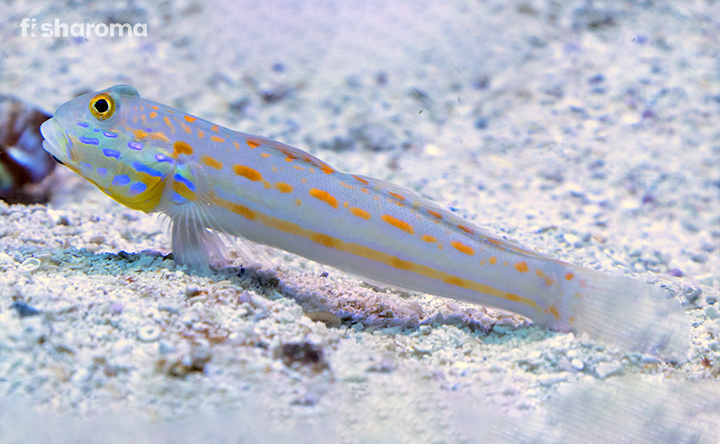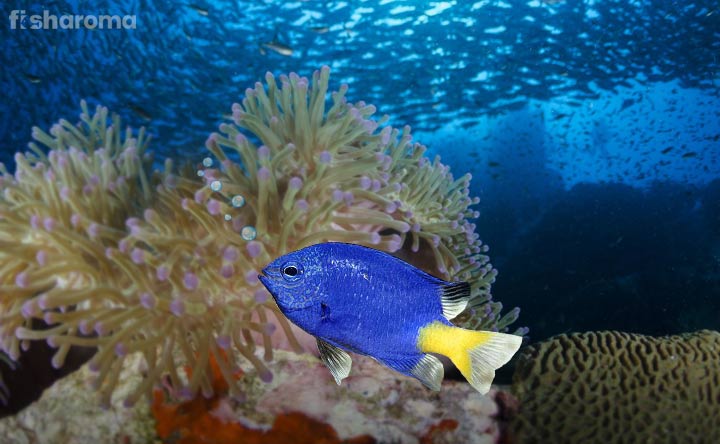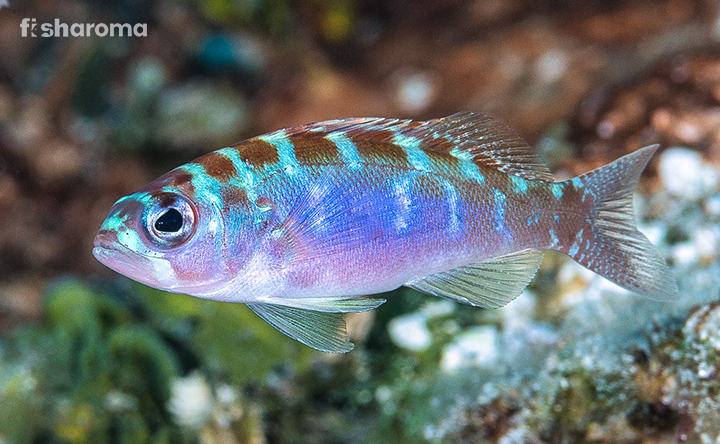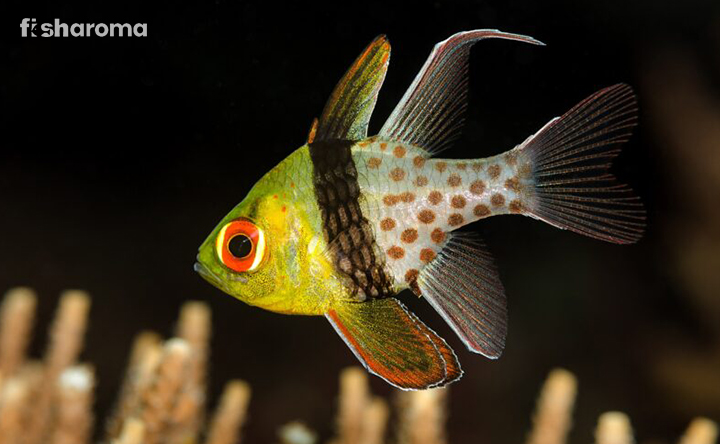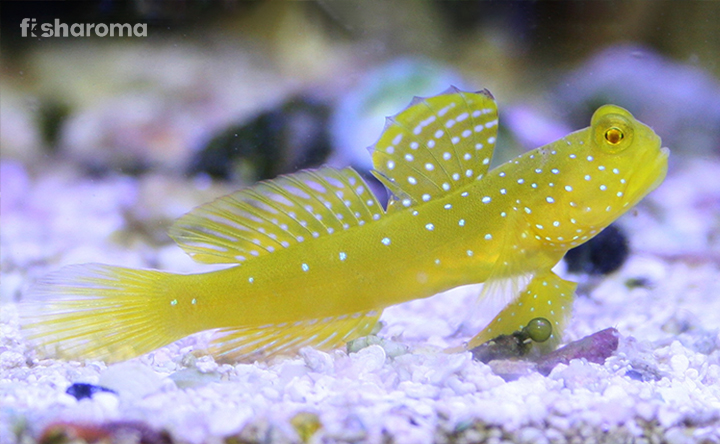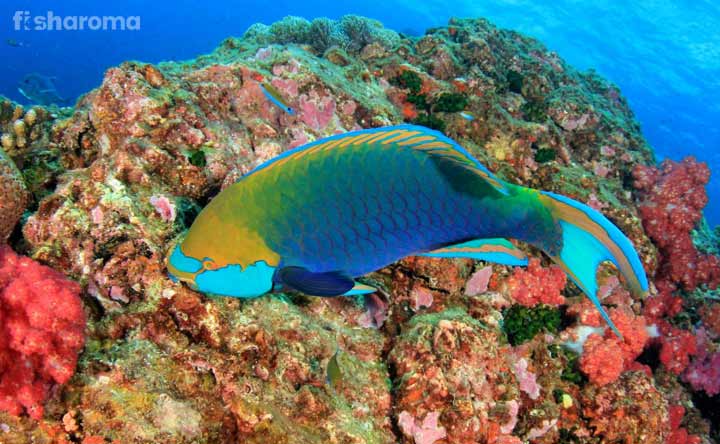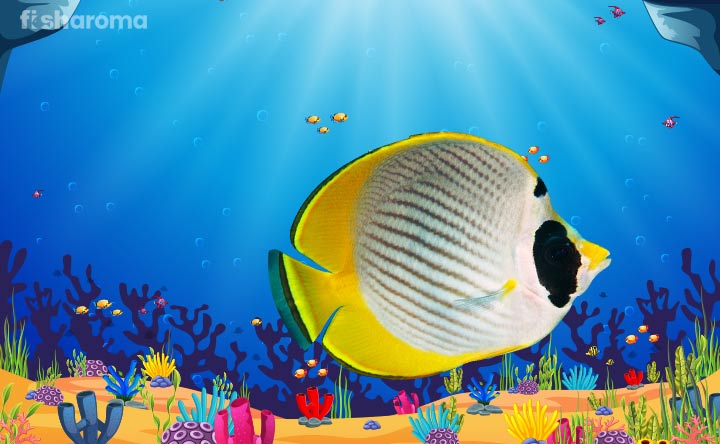The Complete Care Guide of Beautiful Mandarinfish
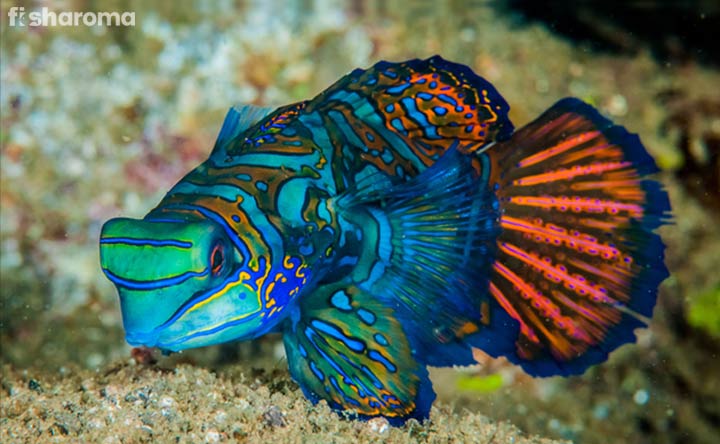
If you are one of those who prefer having a dash of color in your saltwater tank, then we might just have the best answer for you. Regarded as one of the most visually appealing species to inhabit the saltwater, Mandarinfish is a pretty popular choice among fish enthusiasts across the globe. To help you out in petting them, we are providing an extensive guideline to make sure this saltwater species thrive in your fish tank.
Key Specifications of Mandarinfish
Before we get into the nitty-gritty of this marine fish, let us take a quick look at some of its key specifications.
| Scientific Name | Synchiropus splendidus |
| Family | Callionymidae |
| Origin | Western Pacific Ocean |
| Size | 3” (7.6 cm) |
| Color | Multi-Color |
| Care Level | Moderate |
| Lifespan | 5 Years |
| Temperament | Peaceful |
| Compatibility | Moderate |
| Tank Size | 30-Gallons |
| Diet | Carnivore |
Overview
Mandarinfish (Synchiropus splendidus), also known by the name of Mandarin Dragonet is a saltwater species that belongs to the Callionymidae (Dragonet) family. Brightly colored in appearance, the demand for this fish has increased in recent years due to the boom in the fishkeeping business that has made them available worldwide.
Their generic name ‘Synchiropus’ is an amalgamation of two ancient Greek words – ‘Syn’ meaning ‘together’ and ‘Chiropus’ meaning ‘hand-foot’. The term ‘Splendidus’ has been derived from the Latin language and translates to ‘bright’ or ‘glittering’. The popular name ‘Mandarinfish’ has been inspired by the vivid colors of the robes worn by an Imperial Chinese Mandarin.
Mandarinfish is also known by several other names such as Striped Dragonet/Striped Mandarinfish, Green Mandarin, Red Mandarin, Psychedelic Mandarinfish, Mandarin Goby, among others. These are basically the different variants of Mandarinfish. The difference in these variants is in the patterns and colors of their bodies.
Although the International Union for Conservation of Nature (IUCN) hasn’t given them a conservation status, they are pretty threatened due to water pollution and overfishing, particularly for the private aquarium trade.
Origin & Habitat of Mandarinfish
Native to the western region of the Pacific Ocean, Mandarinfish are distributed between the Ryukyu Islands and the Great Barrier Reef in Australia. They are also found in the Coral Triangle of Biodiversity including Malaysia, the Philippines, and Indonesia.
Mandarinfish’s natural habit is in the warm alkaline water that has access to light. You can spot them in in-shore reefs and shallow protected lagoons. They can also be found near the rubble beds of the ocean and under dead corals. Generally, they live at a depth of 1-18 meters of the water surface.
Appearance of Mandarinfish
The vivacious appearance is what makes Mandarinfish so popular among saltwater aquarium owners.
They have a broad head, which is responsible for their unusual appearance. Their pelvic fins help them to ‘walk’ on the seafloor and the substrate of an aquarium. These pelvic fins are generally mistaken as their pectoral fins, but in reality, their pectoral fins are located at the center and are transparent in appearance, with a dash of bright blue. They have four dorsal rays and eight dorsal spines. They also don’t have any anal spines.
Their eyes are red in color with back pupils and they appear large due to the fact that they are raised a bit from their body. Their popped-up eye helps them to eat food in dim light environments.
Unlike most fish, they don’t have scales, although they secrete a toxic mucus to deter their predators. The mucus that they secrete is basically a smelly and bitter slime that also helps prevent diseases. Their bright coloration signifies aposematism to their predators.
Although a Mandarinfish is to a large extent similar to a Goby in terms of body structure and shape, there are numerous differences between the two of them.
Size of Mandarinfish
Mandarinfish are a fairly smaller fish measuring 3” (7.6 cm) in length.
Color of Mandarinfish
Mandarinfish is one of only two vertebrates that are blue in color due to a cellular pigment called cyanophore. The other vertebrate which is blue in color due to this cellular pigmentation is the closely related Psychedelic Mandarin. In every other creature, the blue color is structural in nature.
The different types of this species have different patterns and color forms. The bodies of Green Mandarin have orange stripes over a bright blue background while their blue-greenish face has bold blue stripes on them. Stripes are also seen on their dorsal fins, anal fins and on part of their tail. A striking blue-orange design is also seen on their dorsal fin.
In the case of Red Mandarin, the pelvic fins are red instead of orange. In some rare cases, the entire body is red in color with black stripes. Spotted Mandarins are light gray-green in color with blue, pink and black spots over their bodies.
So basically, you will see different combinations of royal blue, neon green, bright yellow and vibrant orange in a Mandarinfish with shades of purple, pink and red and wavy stripes or spots on them.
Behavior of Mandarinfish
With a peaceful temperament, Mandarinfish are mostly reclusive during the day, hiding in caves or under corals and large rocks. These slow-moving fish spend a considerable amount of their time dwelling at the bottom of the seafloor in search of food.
Despite them being not a highly active fish, they are still very intriguing to watch. However, don’t worry! You can still find them hopping atop coral or perching around the rocks.
It can be said without a shred of doubt that they only feel comfortable to swim around in the open and also eat better when they are comfortable in a tank. When threatened, they immediately withdraw themselves under coral, rocks or sand-bed.
Lifespan of Mandarinfish
In the wild, a Mandarinfish can live up to 10-15 years which is relatively way more than most other saltwater species of its size. However, the number goes down to a mere 2-4 years when they are kept in captivity. This is primarily due to their inability to compete with their tankmates for food. The situation is truer when the food supply is less diverse and less plentiful than what is found in its natural habitat.
Diet of Mandarinfish
Carnivores by nature, Mandarinfish feed themselves by continuously searching for food on the rock surfaces and on the substrate. They feed on protozoans, crustacean, small snails, fish eggs, copepods and worms, and occasionally Benthic organisms. They need food sources that are rich in nutrients.
In a captive environment, copepods are among the very few foods that they consume. In fact, it is their dietary issue that makes them so difficult to pet at home.
You should provide a Mandarinfish a diet that consists of the following:
- Copepod
- Fish Eggs
- Ostracod
- Gastropod
- Gammaridea
- Polychaete Worms
- Harpacticoida
- Bloodworms
- Blackworms
- Frozen Cyclops
- Live Brine Shrimp
- Frozen Mysis Shrimp
You can also feed them frozen forms of the aforementioned shrimps but make sure you thaw it before putting it out in the aquarium. It will take them some time to get used to with the frozen food, but slowly they tend to mostly accept it, but the situation may vary from individual to individual fish.
They are highly resistant to prepared food. Adding live rocks to the aquarium can help benefit the eating conditions of this fish since it will sustain the population of copepods which your Mandarinfish can eat.
We recommend you to keep a close watch on your Mandarinfish while feeding it, especially, if it is residing in a community tank or with other species. You need to ensure that they don’t have to compete for their food since they would fail to do so because of their mild temperament, which would ultimately lead to their demise. In essence, they are not a voracious eater and would not compete for their food. It is a good idea to specifically drop the food exactly where your Mandarinfish is residing at the time of feeding.
In case you are keeping a copepod population in your tank, then you will find them helping you get rid of detritus and algae since they eat them up. Having Phytoplankton in your tank will help the pod population grow and be healthy while helping feed your corals as well.
In order to familiarise your Mandarinfish with different types of food (frozen or pelletised food) other than copepods or brine shrimp, you can place the fish in a quarantine tank or breeding basket and feed them a diet that is composed primarily of copepods and brine shrimp with a small portion of frozen or pelletised food in it. Eventually, they would take a liking to it and after a while when you place them back in the display tank, you can feed them a diet primarily composed of frozen or pelletized food. But, be sure to give them enough time to get used to the new food.
Tank Requirements for Mandarinfish
With the dietary issue solved, let us now focus on another major aspect when it comes to fishkeeping – building the tank. Find out the factors that you need to keep in mind in order to rear a Mandarinfish at home.
Tank Size
Despite their small size, they need a large space to thrive. This means that even for keeping a single Mandarinfish, you would need at least a 30-gallon tank. You can include a pair of Mandarinfish in a 60-gallon tank, but make sure there aren’t more than two of them in the said tank size.
We advise you to have a reef set-up for the tank where you will keep your Mandarinfish.
Substrate
Since a Mandarinfish is used to spending a lot of time looking for food at the bottom of the seafloor, it is crucial to replicate the same in your aquarium. Therefore, have live sand as your substrate which should be 1-2” deep since it would also help your Mandarinfish to dig it to hide in it. Live sand refers to a type of sand that contains beneficial bacteria that helps in keeping the aquarium free of nitrates, nitrites, and ammonia. The grain size of your substrate should be around 2-3mm.
Nature of Lighting
Mandarinfish are not that fussy about the light situation as long as you don’t burden them with a bright light set-up. As we have stated above, their eyes are designed in a manner that helps them see even in a dim-light situation. Just standard aquarium lighting would suffice.
Filter
Although you should include a canister filter and protein skimmer in the tank that hosts a Mandarinfish, we suggest you make sure that the filtration system is not too strong since this fish is a slow swimmer and is vulnerable to get sucked into the filter.
Ornaments
For a single Mandarinfish, 75 lb. of live rock is sufficient. Besides, including aquatic caves is also a good idea, as long as they don’t have any sharp edges. These caves will serve as excellent hiding spots for your fish.
Presence of Flora
Mandarinfish doesn’t have a high requirement of flora, as in vegetation. Therefore, you don’t have to worry about keeping aquatic plants in the tank that houses this fish. Plants can be kept depending on your preference since they don’t play a huge factor in their existence.
With the tank now set-up, let us put our energy into focusing on what type of water you need to put in the tank that contains a Mandarinfish.
Water Type for Mandarinfish
First and foremost, it goes without saying that you need to keep saltwater in your tank for this fish. You can directly buy saltwater from a nearby pet store or can create saltwater at home by mixing sea salt mix with de-ionized and/or Reverse Osmosis (RO) water. The water of the aquarium in which you will keep your Mandarinfish should meet the following requirements:
Temperature
Mandarinfish lives in the warm water of the Pacific Ocean. Thus, the temperature of the water in your tank should reflect the same temperature. The ideal temperature of the water should be 75-81° F (23-27° C). In order to maintain the temperature on a regular basis, you need to install a water heater.
pH Level
The pH level of the water should be 8.1-8.4.
Salinity
Keep the salinity of the water between sg 1.020-1.025.
Hardness
Maintain the carbonate hardness of the water at a level of 8-12 dKH. This is the recommended range of alkalinity for reef-based tanks.
Replacement Procedure
You need to check on a regular basis that there isn’t any excess algae growth or excess accumulation of waste materials inside the tank. This is crucial for maintaining a healthy life for your pet. Remember, not to replace the entire volume of water altogether since that might change the ecological balance of the tank, thereby, giving a shock to their system.
You can choose to replace a part of the water on a fortnightly or monthly basis. In case of a fortnight, you need to replace 10% of the total volume of the water whereas, in case of monthly replacement, you need to replace 25% of the tank’s total water volume.
In both cases, please make sure that the new batch of water that you are putting in your tank has a similar temperature, pH level, salinity, and hardness as that of the existing water in the tank.
Cleaning Method
Never use any soap-based or harsh chemicals to clean your tank because their residue can prove to be fatal for your Mandarinfish. In the case of aquatic caves, rocks, or other ornaments, you need to just clean them by putting them under running water. To clean the interior walls of your tank, just wipe them with a soft cloth.
Compatibility of Mandarinfish
Despite the fact that Mandarinfish are calm, docile and peaceful towards other species, they can get territorial and violent towards the male members of its own species. In fact, males are known to fight each other off until one of them dies. Therefore, it is advised to keep them alone or at the most, with only one female. Harems of one male with multiple females can also be kept.
It should also be noted that since Mandarinfish is a non-competitive fish, you can’t keep them with a species which is a voracious eater since the later would eat all the available food leaving your Mandarinfish hungry and eventually starving which might lead to its death.
Suitable Tankmates for Mandarinfish
The following species have been deemed as suitable tankmates for a Mandarinfish:
- Firefish
- Clownfish
- Green Chromis
- Royal Gramma
- Pajama Cardinals
- Small Damselfish
- Watchman Goby
- Coral Beauty
- Cleaner Shrimp
- Nerite Snails
- Seahorse
Unsuitable Tankmates for Mandarinfish
Larger, aggressive fish such as the following, should be avoided at all cost since there always runs the risk of your Mandarinfish being eaten away by them:
- Anemone
- Scorpionfish
Breeding of Mandarinfish
In the wild, Mandarinfish has a very interesting breeding method. Around 3-5 females gather around the males before the sunset in what seems to be a courtship ritual. A male generally tours different regions across the coral reef and spreads its sperm among multiple females. After this, a female selects a male and clings to its pelvic fins. The pair then joins belly to belly and ascent to the top of the water surface while releasing a cloud of eggs. The eggs hatch after 12 hours and after three weeks, the juveniles start developing similar physical characteristics as of the adults.
In captivity, you have to condition your fish with high-quality foods before the breeding process and also get it accustomed to a particular lighting schedule since this fish spawns generally at night. Mandarinfish are pelagic spawners which means their eggs float on the water surface until they hatch.
We suggest you use a separate breeding tank in order to save the juveniles from other fish. With the right conditions in hand, Mandarinfish can spawn every week for a few months.
Mandarinfish Diseases
Although it is a hardy fish that is less vulnerable to many diseases, it doesn’t mean that they are immune to every disease. Of course, the mucus layer over their body prevents them from many diseases but they can become susceptible to other illnesses. Look out for the following symptoms in them:
- Discoloration
- Flashing
- Loss of Appetite
- Darting
- Frayed Fin
- Rapid Ventilation
A poor water condition and a poor diet will have a disastrous effect on the health of a Mandarinfish. They also suffer from fin rot which you can figure out if you see frayed or deteriorate fin in them or if you witness redness at their fin base. Consult a marine veterinarian immediately in this circumstance.
Furthermore, if you see cysts on the gills, skin or fins of this fish, it means that they are suffering from Marine Ich, which also leads to pale coloring, excess skin mucus and labored respiration in them. In such a case, check your tank to see if it has been inhabited by any parasite or not and get rid of it as soon as possible, and if required, get help from a marine veterinarian
Interesting Facts about Mandarinfish
- Male Mandarinfish have longer and more pointed dorsal fins than females.
- Mandarinfish move by briskly pulsating their fins, which resembles the movement of a Hummingbird.
- Laos issued a 39-kip postage stamp featuring Mandarinfish in the year 1987 while the Federated States of Micronesia also issued a 40-cent postage stamp in 1993 featuring Mandarinfish as well.
Summary
Vivacious in appearance, Mandarinfish are saltwater species that are extremely hardy in nature which makes them resistant to most diseases. Their peaceful, shy and docile nature requires them to be kept alone or only with their opposite sex. A picky eater, you would have to give a lot of effort into feeding it. But, once you cross that hurdle, this is a great companion for you. We hope with the help of our sensitive care guide, you are in a better position now to raise them at your home.
Other Popular Fish Guide for Your Aquarium
Have a look at the guidelines of some of the other popular fish for your aquarium.
- Emperor Angelfish: Gorgeous flat-bodied saltwater species Emperor Angelfish lights up your aquarium with their shimmering colors. Learn how to pet them in your tank from here.
- Crowntail Betta: Owner of one of the most beautiful fins among all aquarium species, the Crowntail Betta has a look to behold. Learn everything you need to know in order to pet them at your home from this space.
- Pipefish: If you are looking for an unconventional yet popular fish to rear at your home, this is the guideline you need to read.


